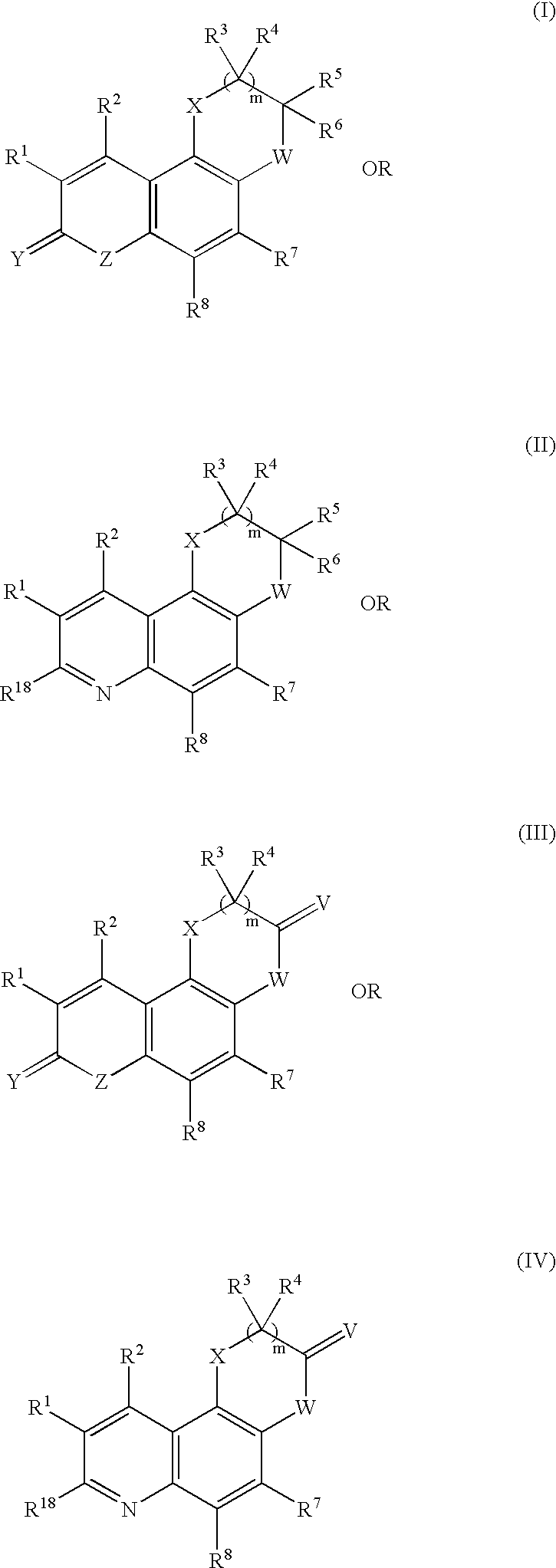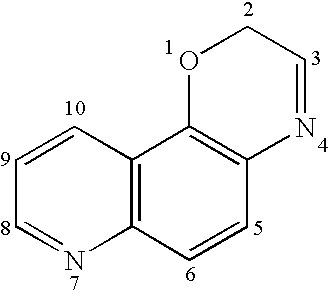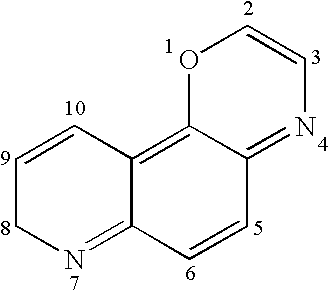Tricyclic quinolinone and tricyclic quinoline androgen receptor modulator compounds and methods
a technology of tricyclic quinolinone and quinoline, which is applied in the field of nonsteroidal compounds, can solve the problems of modulators of steroid receptors and patient homeostatic imbalances
- Summary
- Abstract
- Description
- Claims
- Application Information
AI Technical Summary
Benefits of technology
Problems solved by technology
Method used
Image
Examples
example 1
(3R)-2,3,4,7-Tetrahydro-3-methyl-10-(trifluoromethyl-8H-[1,4]oxazino[2,3-f]quinolin-8-one (Compound 101, Structure 9 of Scheme II, where R1, R3, R4, R5,=H, R2=trifluoromethyl, R6=Me)
[0150]5-Amino-7-chloro-3,4-dihydro-4-hydroxy-4-(trifluoromethyl)-1H-quinolin-2-one: To a solution of 5-chloro-1,3-phenylenediamine (15.0 g, 0.105 mol) in 70 mL ethanol was added ethyl 4,4,4-trifluoroacetoacetate (20.4 g, 0.111 mol), then the mixture was heated at reflux for 18 h. The solvent was removed under reduced pressure until the product began to precipitate. The material was allowed to crystallize for 2 h, whereupon it was filtered and rinsed with cold ether to afford 10.9 g (37%) of 5-amino-7-chloro-3,4-dihydro-4-hydroxy-4-(trifluoromethyl)-1H-quinolin-2-one, a tan solid. The filtrate was concentrated until solid began to precipitate and afforded an additional 3.0 g (10%). 1H NMR (400 MHz, acetone-d6) δ 11.0 (broad s, 1H), 9.64 (s, 1H), 7.42 (t, 1H, J=8.1), 6.99 (d, 1H, J=8.1), 6.90 (s, 1H), 6.79...
example 2
(3R)-2,3,4,7-Tetrahydro-3,4-dimethyl-10-(trifluoromethyl)-8H-[4]oxazino[2,3-f]quinolin-8-one (Compound 102, Structure 11 of Scheme II, where R1, R3, R4, R5,=H, R2 trifluoromethyl, R6=Me, R13=CH3)
[0165]General Method 5: Reductive amination of a 2H-[1,4]oxazino[2,3-f]quinoline or an 8H-[1,4]oxazino[2,3-f]quinolin-8-one derivative with sodium cyanoborohydride and an aldehyde, its hydrate, or its hemiacetal. A solution of the 2H-[1,4]oxazino[2,3-f]quinoline or 8H-[1,4]oxazino[2,3-f]quinolin-8-one (1 equiv) and the aldehyde, its hydrate or hemiacetal (10 equiv) in acetic acid or trifluoroacetic acid, was stirred at room temperature for 2 h, whereupon sodium cyanoborohydride (5 equiv) was added portionwise. The solution was stirred for 12–24 h at rt, then poured into cold saturated NaHCO3 (pH 8–10). The aqueous layer was extracted with EtOAc (2×40 mL / mmol) and the combined organic layers were washed with brine, dried over MgSO4, filtered, concentrated and purified as indicated, or used di...
example 3
(3R)-4-Ethyl-2,3,4,7-tetrahydro-3-methyl-10-(trifluoromethyl)-8H-[1,4]oxazino[2,3-f]quinolin-8-one (Compound 103, Structure 11 of Scheme II, where R1, R3, R4, R5,=H, R=trifluoromethyl, R6=Me, R13 CH2CH3)
[0167]General Method 6: Reductive amination of a 2H-[1,4]oxazino[2,3-]quinoline or an 8H-[1,4]oxazino[2,3-f]quinolin-2-one with sodium borohydride with acetic acid or a substituted acetic acid. To a solution of the 2H-[1,4]oxazino[2,3-f]quinoline or 8H-[1,4]oxazino[2,3-f]quinolin-2-one in a substituted acetic acid was added NaBH4 pellets (5–10 equiv). After 12–24 h, the reaction was carefully poured into cold saturated NaHCO3. The aqueous layer was extracted with EtOAc (2×40 mL / mmol) and the combined organic layers were washed with brine, dried over MgSO4, filtered, concentrated and the compound was purified as indicated.
[0168](3R)-4-Ethyl-2,3,4,7-tetrahydro-3-methyl-10-(trifluoromethyl)-8H-[1,4]oxazino[2,3-f]quinolin-8-one (Compound 103, Structure 11 of Scheme II, where R1, R3, R4, ...
PUM
| Property | Measurement | Unit |
|---|---|---|
| pH | aaaaa | aaaaa |
| temperature | aaaaa | aaaaa |
| temperature | aaaaa | aaaaa |
Abstract
Description
Claims
Application Information
 Login to View More
Login to View More - R&D
- Intellectual Property
- Life Sciences
- Materials
- Tech Scout
- Unparalleled Data Quality
- Higher Quality Content
- 60% Fewer Hallucinations
Browse by: Latest US Patents, China's latest patents, Technical Efficacy Thesaurus, Application Domain, Technology Topic, Popular Technical Reports.
© 2025 PatSnap. All rights reserved.Legal|Privacy policy|Modern Slavery Act Transparency Statement|Sitemap|About US| Contact US: help@patsnap.com



